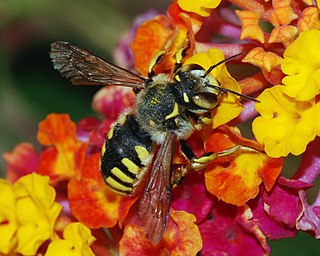
Anthidium is a genus of bees often called carder or potter bees, who use conifer resin, plant hairs, mud, or a mix of them to build nests. They are in the family Megachilidae which is cosmopolitan in distribution and made up of species that are mostly solitary bees with pollen-carrying scopa that are only located on the ventral surface of the abdomen. Other bee families have the pollen-carrying structures on the hind legs. Typically species of Anthidium feed their brood on pollen and nectar from plants. Anthidium florentinum bees are distinguished from most of its relatives by yellow or brick-red thoracic bands. They fly all summer and make the nests in holes in the ground, walls or trees, with hairs plucked from plants.

Anthidium manicatum, commonly called the European wool carder bee is a species of bee in the family Megachilidae, the leaf-cutter bees or mason bees.
Anthidium taeniatum is a species of bee in the family Megachilidae, the leaf-cutter, carder, or mason bees.
Anthidium severini is a species of bee in the family Megachilidae, the leaf-cutter, carder, or mason bees.
Anthidium septemspinosum is a species of bee in the family Megachilidae, the leaf-cutter, carder, or mason bees.
Anthidium rubripes is a species of bee in the family Megachilidae, the leaf-cutter, carder, or mason bees.
Anthidium pulchellum is a species of bee in the family Megachilidae, the leaf-cutter, carder, or mason bees.

Anthidium oblongatum is a species of bee in the family Megachilidae, the leaf-cutter, carder, or mason bees.
Anthidium montanum is a species of bee in the family Megachilidae, the leaf-cutter, carder, or mason bees.

Anthidium maculosum is a species of bee in the family Megachilidae, the leaf-cutter, carder, or mason bees. It is a solitary bee where the males are territorial and the females take part in polyandry. The males of A. maculosum differ from most other males of bee species because the males are significantly larger than females. In addition, subordinate males that act as satellites are smaller than territory-owning males. This species can be found predominately in Mexico and the United States.
Anthidium latum is a species of bee in the family Megachilidae, the leaf-cutter, carder, or mason bees.
Anthidium garleppi is a species of bee in the family Megachilidae, the leaf-cutter, carder, or mason bees.
Anthidium funereum is a species of bee in the family Megachilidae, the leaf-cutter, carder, or mason bees.
Anthidium friesei is a species of bee in the family Megachilidae, the leaf-cutter, carder, or mason bees.
Anthidium diadema is a species of bee in the family Megachilidae, the leaf-cutter, carder, or mason bees.
Anthidium echinatum is a species of bee in the family Megachilidae, the leaf-cutter, carder, or mason bees.

Anthidium auritum is a species of bee in the family Megachilidae, the leaf-cutter, carder, or mason bees.
Anthidium atricaudum is a species of bee in the family Megachilidae, the leaf-cutter, carder, or mason bees.
Anthidium tesselatum is a species of bee in the family Megachilidae, the leaf-cutter, carder, or mason bees.




